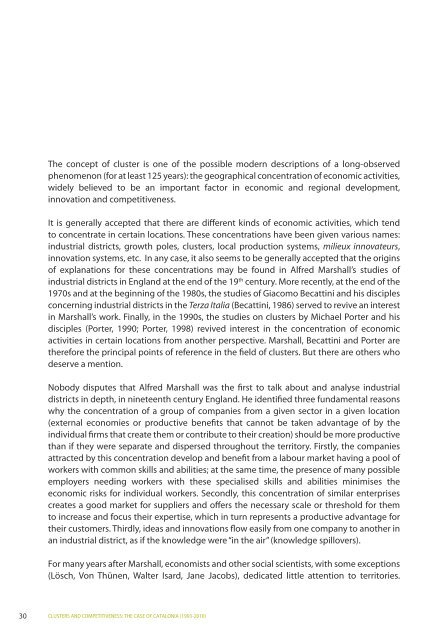Clusters and competitiveness - PRO INNO Europe
Clusters and competitiveness - PRO INNO Europe
Clusters and competitiveness - PRO INNO Europe
Create successful ePaper yourself
Turn your PDF publications into a flip-book with our unique Google optimized e-Paper software.
The concept of cluster is one of the possible modern descriptions of a long-observed<br />
phenomenon (for at least 125 years): the geographical concentration of economic activities,<br />
widely believed to be an important factor in economic <strong>and</strong> regional development,<br />
innovation <strong>and</strong> <strong>competitiveness</strong>.<br />
It is generally accepted that there are different kinds of economic activities, which tend<br />
to concentrate in certain locations. These concentrations have been given various names:<br />
industrial districts, growth poles, clusters, local production systems, milieux innovateurs,<br />
innovation systems, etc. In any case, it also seems to be generally accepted that the origins<br />
of explanations for these concentrations may be found in Alfred Marshall’s studies of<br />
industrial districts in Engl<strong>and</strong> at the end of the 19 th century. More recently, at the end of the<br />
1970s <strong>and</strong> at the beginning of the 1980s, the studies of Giacomo Becattini <strong>and</strong> his disciples<br />
concerning industrial districts in the Terza Italia (Becattini, 1986) served to revive an interest<br />
in Marshall’s work. Finally, in the 1990s, the studies on clusters by Michael Porter <strong>and</strong> his<br />
disciples (Porter, 1990; Porter, 1998) revived interest in the concentration of economic<br />
activities in certain locations from another perspective. Marshall, Becattini <strong>and</strong> Porter are<br />
therefore the principal points of reference in the field of clusters. But there are others who<br />
deserve a mention.<br />
Nobody disputes that Alfred Marshall was the first to talk about <strong>and</strong> analyse industrial<br />
districts in depth, in nineteenth century Engl<strong>and</strong>. He identified three fundamental reasons<br />
why the concentration of a group of companies from a given sector in a given location<br />
(external economies or productive benefits that cannot be taken advantage of by the<br />
individual firms that create them or contribute to their creation) should be more productive<br />
than if they were separate <strong>and</strong> dispersed throughout the territory. Firstly, the companies<br />
attracted by this concentration develop <strong>and</strong> benefit from a labour market having a pool of<br />
workers with common skills <strong>and</strong> abilities; at the same time, the presence of many possible<br />
employers needing workers with these specialised skills <strong>and</strong> abilities minimises the<br />
economic risks for individual workers. Secondly, this concentration of similar enterprises<br />
creates a good market for suppliers <strong>and</strong> offers the necessary scale or threshold for them<br />
to increase <strong>and</strong> focus their expertise, which in turn represents a productive advantage for<br />
their customers. Thirdly, ideas <strong>and</strong> innovations flow easily from one company to another in<br />
an industrial district, as if the knowledge were “in the air” (knowledge spillovers).<br />
For many years after Marshall, economists <strong>and</strong> other social scientists, with some exceptions<br />
(Lösch, Von Thünen, Walter Isard, Jane Jacobs), dedicated little attention to territories.<br />
30 CLUSTERS AND COMPETITIVENESS: THE CASE OF CATALONIA (1993-2010)
















